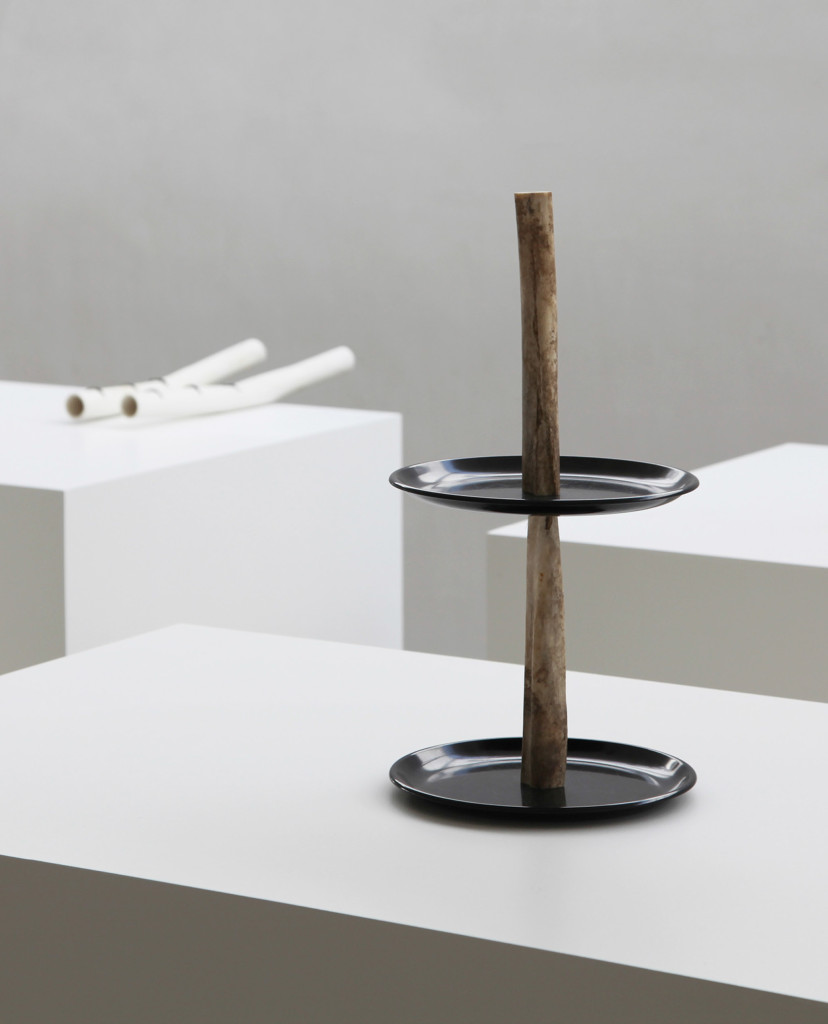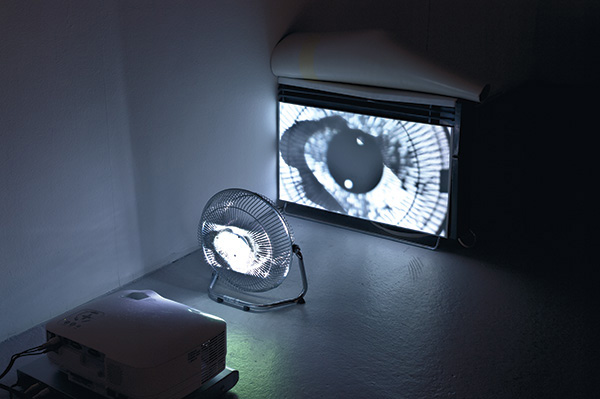The (Re)Shape of Things: Michael E. Smith
Dominic Molon

Michael E. Smith installation view, Susan Hilberry Gallery 25 April - 7 June 2014

Michael E. Smith, Trouble Stand, 2011. Photo credit: Alexander Koch.
The work of Micheal E. Smith is often hastily liquided as reflection on speed-obsessed, frenetically consuming American culture, especially in relation to the urban collapse of Detroit. Dominic Molon examines the artist’s work with a sharper sensibility, demonstrating that there is a lot more behind the radical transformation of refuse into sculpture done by Smith: from exaggerated knowledge of materials to the use and tactical revitalization of installation spaces.
The first impression of Michael E. Smith’s work is the startling effrontery of its abjection. His manipulations and syntheses of cast-off objects and materials willfully resist justifying themselves as art. Rejecting the century-old common logic of utilizing the art context to elevate or redeem everyday phenomena—Picasso’s collage-sculptures, Duchamp’s urinal, and Tatlin’s “Counter Corner Reliefs” vying in a three-way tie for first in that regard—his works initially seem to have the opposite effect of degrading the aesthetic context, of bringing the museum or gallery space down to the level of refuse. Yet he pulls it back through an ingenious integration of disparate substances and things; a knowing encouragement of the natural properties of a given situation to take its course and dictate the ultimate form of a work; and a calculated use of the existing atmospheric dynamics of a given exhibition site. Smith’s exploration of the inherent and essential functions and attributes of various forms of matter, and strikingly unexpected new applications and utilizations of it, prompts a reflexively dialectical relationship between decay and desuetude and recycling and repurposing.
In this sense, Smith’s work possesses sensibilities that are both quintessentially American and absolutely un- or anti-American. It simultaneously evokes and makes direct use of the detritus of a narcissistically wasteful culture that scorns conservation and valorizes rampant consumption. His redemptive project runs contrary to this “more is more” philosophy through its industrious ability to make more with less, if not next to nothing. Much is typically made of Smith’s immediate working context of Detroit and his work’s reflection of that city’s identification with urban blight. This oversimplification not only ignores the increasingly widespread decline, if not devastation, of the entire American landscape, but sells short both Detroit and the dynamic cosmopolitanism of the work itself. One might propose, however, that it is not only unavoidable for it to be seen within that context, but also that it operates in manner similar to the way that experimental rock bands such as Destroy All Monsters, Pere Ubu, and Throbbing Gristle in the 1970s seemed to channel the entropy and dysfunction of civilization occurring around them (in Detroit, Cleveland, and Sheffield, England, respectively) into the very form of their music. In this sense, “Detroit,” or a sense of urban collapse in general, asserts itself in his work less as a cultural referent or corollary, but rather as integrally informing its structure and composition.
One might also examine the work through the lens of serial killer Hannibal Lecter’s instructions to trainee FBI agent Clarice Starling, from the 1991 film The Silence of the Lambs: “First principles, Clarice. Simplicity. Read Marcus Aurelius. Of each particular thing ask: what is it in itself? What is its nature?” (Not an un-apropos consideration given the desperate and furtive feel of the work and the somewhat ominous, basement-like appearance that the unlit exhibition spaces preferred for its presentation to take on.) Smith’s sculptures and other works suggest a profound and thorough understanding of their base materials in that their transformation into a radically different new entity or experience could only be achieved with that prior knowledge. As such, his works are anything but arbitrarily conceived or constructed but instead are the product of an acute and nuanced appreciation for what substances can do and what they can’t—whether they were intended to or not. A sculpture of a truncated tracksuit pant-leg whose interior is lined with crumbled foam is exemplary of Smith’s canny re-imagining of the structure, function, and purpose of both object and material. Hung perfunctorily on the wall to reveal its interior, the pant leg reveals enough volume to cover a human leg, yet that void suddenly becomes something else, a vacuum for contemplation. (How often have YOU looked into a pant leg for more than the split second it takes to put your foot in it?) The foam similarly has the typically technical function of FILLING a volume created by an outer layer in order to provide structure and support. Here, however, it offers only another lining, one that demonstrates just why it remains the un- (or rarely) seen filler of a pillow, cushion, or stuffed toy. Smith’s materials in this instance do what they are intended to do, essentially, yet his intervention pulls them far away into a space where they exist and are understood in a completely different way. This estrangement of objects and substances from themselves, simply by making their principle function or purpose work against or beside itself, is exacerbated by Smith’s tactical use of every possible option possessed by an exhibition space. In his 2011 presentation at Benevento Gallery in Los Angeles, an extremely overlookable opening in the ceiling was deployed to house a work featuring insects encased in clear resin. It joined blue, yellow, and red spotlights and the ambient light of the gallery’s front window in providing the only illumination for the rest of the work in the space. This approach—opting only or primarily for existing light for works lacking an inherent light source—is consistent with the other aspects of Smith’s practice, suggesting a rejection of the kind of inauthentic theatrics that have historically accompanied and accentuated the presentation of art. For example, in his installation in the Contemporary Art Museum, St. Louis’ Front Room project space, the aforementioned pant-leg sculpture, was presented alongside an oatmeal-encrusted guard shield of a weed whacker. The pitched form of both objects—unusually presented side-by-side—echoed the angled shadow created by residual light pouring over the open ceiling from the exhibition next door. Similar to his work’s redemption of discarded objects and materials, his activation of unconsidered spatial and structural details in unexpected ways prompts a greater appreciation of the extant properties of an exhibition site, converting it into a virtual extension of the work itself.
The sheer nerve of presenting non-light emitting work in deliberately unlit spaces underscores the drily sophisticated sense of humor that informs Smith’s practice, albeit one that is much more circumstantial than intentional. The works are not so much Dadaist sight-gags as inheritors to a more deadpan tradition of the archly comedic in art, that operates on mordant wit rather than slapstick. In this sense, Smith’s sculptural works evoke the abject humor of Mike Kelley’s arrangements of stuffed animals and thrift store blankets and the entropic yet funny auto-cannibalism of Tom Friedman’s work. A 2009 sculpture featuring a mannequin part covered with gray latex paint is characteristic in this regard. Its bristled surface and breast-cup-like shape initially prompts comparison to Duchamp’s Prière de toucher (Please Touch), 1947, a relief of a woman’s breast mounted on a cloud of black velvet. Whereas Duchamp’s gesture flaunted and ridiculed the fetishistic nature of masculine sexuality’s tendency to prioritize the part object, Smith’s sculpture (like all of his others) is hardly fetishistic—if anything it repels the viewer with its un-adulterated-ness or mal-adulterated-ness—a strangely droll sexual object that only a masochist might love. Other works, such as a garden hose bent and segmented into an elegantly stylized form, humorously redeems the ubiquitous backyard gardening aggravation of kinks developing in this object that cut off the water supply. One might argue that without the implicit and unforced levity of Smith’s gestures, the whole project might otherwise read as impossibly maudlin.
In its own humble and entirely unprepossessing way, Smith’s work offers a bracing riposte to the high production values of spectacle culture—to which much contemporary art practice is not immune—and an urgently relevant reminder of the value in looking at the overlooked. This extends to a use of exhibition space that reinforces this notion, one that is theatrical, yet only insofar as the “theater” provides its own unadulterated and unenhanced stagecraft. Just as Smith allows and encourages the spaces to be what they are and achieve their latent potential, so too does he give materials, objects, substances, and situations the liberty to become what they’re going to become and realize themselves within the context of art.
Originally published in Mousse, 2012. Reprinted courtesy of Dominic Molon and Mousse.